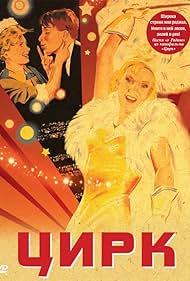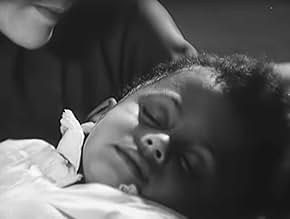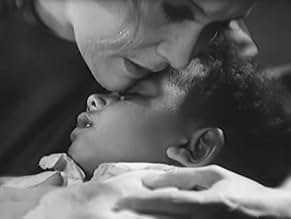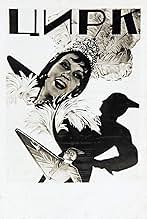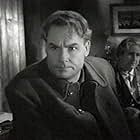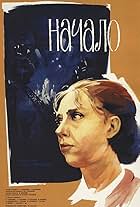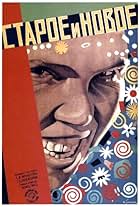In the mid-1930s, circus actress Marion Dixon flees the United States with her young black son. Arriving with an original attraction in the USSR, she finds friends here and decides to stay f... Read allIn the mid-1930s, circus actress Marion Dixon flees the United States with her young black son. Arriving with an original attraction in the USSR, she finds friends here and decides to stay forever.In the mid-1930s, circus actress Marion Dixon flees the United States with her young black son. Arriving with an original attraction in the USSR, she finds friends here and decides to stay forever.
- Awards
- 1 win
Lyubov Orlova
- Marion Dixon
- (as L.P. Orlova)
Yevgeniya Melnikova
- Rayechka, the director's daughter
- (as E. Melnikova)
Vladimir Volodin
- Circus Director - Ludvig Osipovich
- (as V. Volodin)
Sergey Stolyarov
- Martinov - Ivan Petrovich
- (as S. Stolyarov)
Pavel Massalsky
- Kneishitz - Entrepreneur
- (as N. Massalskij)
Aleksandr Komissarov
- Skameykin - Amateur Designer
- (as A. Komissarov)
Jim Patterson
- Jimmy, Marion's son
- (as Dzh. Patterson)
Fyodor Kurikhin
- Captain Borneo, animal tamer
- (as F. Kurikhin)
Sergei Antimonov
- Circus Presenter
- (as S. Antimonov)
Solomon Mikhoels
- Lullaby Singer
- (as S. Mikhoels)
Pavel Geraga
- Lullaby Singer
- (as P. Geraga)
Lev Sverdlin
- Lullaby Singer
- (as L. Sverdlin)
Vladimir Kandelaki
- Lullaby Singer
- (as V. Kandelaki)
Coretti Arle-Titz
- baby Jim's nanny
- (uncredited)
Vladimir Durov
- Clown
- (uncredited)
Emmanuil Geller
- Circus Orchestra Conductor
- (uncredited)
Storyline
Did you know
- TriviaIn the scene where people sing a lullaby in various languages to the black child, the bit sung in Yiddish by Solomon Mikhoels was cut out of the film for distribution in the USSR, for a time when a state-backed anti-Semitism campaign was unleashed.
- Alternate versionsA colorized version was released on Blu-ray in Russia in 2012.
- ConnectionsFeatured in Komediya davno minuvshikh dney (1980)
- SoundtracksVykhodnoy marsh
Music by Isaak Dunaevskiy
Featured review
Circus which was written by Brigori Aleksandrov and was directed by Aleksandrov and I. Simkov was released in 1936. The movie which is a comedy/musical centers on a U.S.-Vaudeville dancer Marion Dixon on tour with her German manager Von Kneischitz in Mosocow. The woman's act entails her being shot from a canon and is a crowd favorite. When Marion begins to fall in love with the handsome Ivan Petrovich Martynov(Sergei Stolvarov) she falls in love with Moscow as well. When Marion decides she wants to remain in Moscow this does not make her German manager happy. Her manager insists that if she tries to stay in Moscow she will never be accepted after he tells everyone about her son who is half black. As the film progresses and comes to a close Marion confesses her love to Martynov and Kneischitz shows Marion's black child to the circus audience. While Kneischitz thinks he is going to ruin Marion, the opposite occurs. The Russian people accept the child. In the final scene they all march off in unity and happiness.
The purpose of this film is clearly propaganda. The author seems to try and convey multiple messages in this film for that purpose. One message the author tries to convey in this film is that the Russian people are good and the German people are bad. This message is used as propaganda in order to create and increase nationalism amongst the Russian people during a time of conflict between Russia and Germany. Another message which the author tries to convey is not apparent until the end of the movie. This message is the portrayal of the Russian way of living, during the time of the Soviet Union, as the best way of living. The author conveys this message of equality and bliss amongst the Russian people for the purpose of propaganda in the final scenes.
In my opinion the author and the Committee of Cinema Affairs want to portray Stalin and Lenin as Gods and Communism as a type of religion. This is reflected in what I believe to be the theme of the film; The Soviet way of living is the best way of living because all Russian people are equal and happy. This theme reflects the author's purpose of the film as propaganda.
I liked some aspects of the film and some aspects I did not necessarily like but in a way I understood. The parts of the film that I did like were: the love story of Marion and Martynov, the humor associated with the acts of the circus clowns, and the conveyed message of equality and bliss. However some parts of the film may rub certain individuals the wrong way. For example: the way the black child is hidden from the public until the very end of the film. Although I understood that part of this use of a black child was to portray the existence of slavery in the United States during this time period. Another aspect of the film that may be offensive to some is the way that Americans(through the image of Marion) are portrayed as dumb and Russians superior. I would suggest this film to a friend because the film captures a person's interest, is controversial, and is funny. However this film is not for everyone, and I would mostly recommend it for the purpose of study in film or history, not pleasure.
The purpose of this film is clearly propaganda. The author seems to try and convey multiple messages in this film for that purpose. One message the author tries to convey in this film is that the Russian people are good and the German people are bad. This message is used as propaganda in order to create and increase nationalism amongst the Russian people during a time of conflict between Russia and Germany. Another message which the author tries to convey is not apparent until the end of the movie. This message is the portrayal of the Russian way of living, during the time of the Soviet Union, as the best way of living. The author conveys this message of equality and bliss amongst the Russian people for the purpose of propaganda in the final scenes.
In my opinion the author and the Committee of Cinema Affairs want to portray Stalin and Lenin as Gods and Communism as a type of religion. This is reflected in what I believe to be the theme of the film; The Soviet way of living is the best way of living because all Russian people are equal and happy. This theme reflects the author's purpose of the film as propaganda.
I liked some aspects of the film and some aspects I did not necessarily like but in a way I understood. The parts of the film that I did like were: the love story of Marion and Martynov, the humor associated with the acts of the circus clowns, and the conveyed message of equality and bliss. However some parts of the film may rub certain individuals the wrong way. For example: the way the black child is hidden from the public until the very end of the film. Although I understood that part of this use of a black child was to portray the existence of slavery in the United States during this time period. Another aspect of the film that may be offensive to some is the way that Americans(through the image of Marion) are portrayed as dumb and Russians superior. I would suggest this film to a friend because the film captures a person's interest, is controversial, and is funny. However this film is not for everyone, and I would mostly recommend it for the purpose of study in film or history, not pleasure.
Details
- Runtime1 hour 30 minutes
- Color
- Sound mix
- Aspect ratio
- 1.37 : 1
Contribute to this page
Suggest an edit or add missing content

